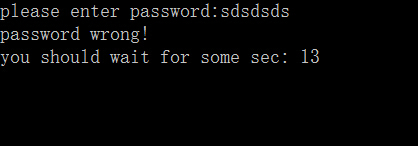37,719
社区成员
 发帖
发帖 与我相关
与我相关 我的任务
我的任务 分享
分享 当我多次输错以后,显示让我等待,但是我依旧多次输入,时间到了以后,按以前的情况会再次被raw_input读入,这下不会了。
当我多次输错以后,显示让我等待,但是我依旧多次输入,时间到了以后,按以前的情况会再次被raw_input读入,这下不会了。
 代码中我添加了os.system('pause')在输入的前面
代码中我添加了os.system('pause')在输入的前面
while right!=1:
os.system('pause')
pswd1=raw_input("please enter password:")right=0
while right!=1:
pswd1=raw_input("please enter password:")
pswd=self.getPasswd()
if pswd1==pswd:
right=1
self.setWrongTimes(0)
else:
self.setWrongTime(time.time()) #record the time when wrong input occur
self.wrongTimes+=1
print "password wrong!"
self.setWrongTimes(self.wrongTimes) # set wrongs times
self.WiatTime() # wiat def WiatTime(self): #according the password input wrong times set a wait time,at this time you can't enter password
times=self.getWrongTimes() #wrong times
wrongTime =self.getWrongTime() #the time last wrong input accour
if times <= 3:
pass
if times >3:
currentTime=long(time.time())
waitTime=currentTime-wrongTime
if waitTime>times*times:
pass
else:
timeYouShouldWait=times*times-(currentTime-wrongTime)
print "you should wait for some sec: ",
for i in range(timeYouShouldWait):
time.sleep(1)
theTimeLave=timeYouShouldWait-i
if theTimeLave<10:
print "\b\b\b",str(theTimeLave),
elif theTimeLave<100:
print "\b\b\b\b",str(theTimeLave),
elif theTimeLave<1000:
print "\b\b\b\b\b\b",str(theTimeLave),
print 
#include <unistd.h>
#include <stdio.h>
#include <termios.h>
void main(void)
{
char c;
sleep(5);
printf("wake up\n");
tcflush(0,TCIFLUSH);
while((c=getchar())!='\n'&&c!=EOF)putchar(c);
return;
}
import time
import subprocess
import sys
from termios import tcflush, TCIOFLUSH
alarm1 = int(raw_input("How many minutes (alarm1)? "))
while (1):
time.sleep(60*alarm1)
print "Alarm1"
sys.stdout.flush();
tcflush(sys.stdin, TCIOFLUSH)
doit = raw_input("Continue (Y/N)?[Y]: ")
print "Input",doit
if doit == 'N' or doit=='n':
print "Exiting....."
break
import os
oldf=sys.stdin
f=open(os.devnull, 'r')
sys.stdin=f